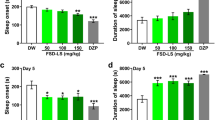The state of peroxidation processes in the basal ganglia (caudate nucleus, globus pallidus, nucleus accumbens, amygdalar complex) of the rat brain was studied in conditions of an altered photoperiod. The results showed that changes to the normal photoperiodicity led to metabolic changes in these brain structures. In conditions of constant light, the basal nuclei showed increased lipid and protein peroxidation processes, with increases in the intensity of fibrinolysis and proteolysis and decreases in the activities of antioxidant defense system enzymes. In conditions of constant darkness, there were changes in fibrinolytic and proteolytic processes which were in different directions in different structures, along with decreases in free-radical processes on the background of the accumulation of modified proteins.
Similar content being viewed by others
References
É. B. Arushanyan, “The epiphysis and the organization of behavior,” Usp. Fiziol. Nauk., 22, No. 4, 122–141 (1991).
É. B. Arushanyan, “The striatum in the system of central mechanisms for the control of biorhythms,” Zh. Vyssh. Nerv. Deyat. im. I. P. Pavlova, 48, No. 2, 296–303 (1998).
É. B. Arushanyan and K. B. Ovanesov, “The suprachiasmatic nucleus of the hypothalamus and the organization of daily periodicity,” in: Chronobiology and Chronomedicine [in Russian], Triada-X, Moscow (2000), pp. 25–40.
V. A. Baturin, E. V. Shchetinin, É. B. Arushanyan, and G. I. Manzhikova, “The striatum and the organization of forced swimming in rats,” Zh. Vyssh. Nerv. Deyat., 39, No. 4, 633–639 (1989).
L. A. Bondarenko, “Current concepts in the physiology of the epiphysis,” Neirofiziologiya, 29, No. 3, 212–237 (1997).
V. B. Gavrilov and M. I. Mishkorudnaya, “Spectrophotometric assay of lipid hydroperoxides in plasma,” Lab. Delo, No. 3, 33–35 (1983).
O. V. Goiko, Practical Applications of Statistics for the Analysis of Medical-Biological Data [in Ukrainian], Kiev (2004).
I. I. Zamor’skii, V. P. Pishak, and I. F. Meshchishen, “Effects of epithalamin on the intensity of the oxidative modification of plasma proteins in rats in acute hypoxia at different photoperiod durations,” Liki, No. 5–6, 83–86 (1999).
I. I. Zamor’skii, V. P. Pishak, and I. F. Meshchishen, “The effects of melatonin on the photoperiodic change in brain glutathione in acute hypoxia,” Fiziol. Zh. (Ukr.), 45, No. 4, 69–76 (1999).
I. I. Zamor’skii and V. P. Pishak, “Functional organization of the photoperiod system of the brain,” Usp. Fiziol. Nauk., 34, No. 4, 37–53 (2003).
M. A. Korolyuk, L. I. Ivanova, I. G. Maiorova, and V. E. Tokarev, “A method for assay of catalase activity,” Lab. Delo, No. 1, 16–18 (1988).
I. F. Meshchishen, “A method for assay of oxidative modifications of plasma (serum) proteins,” Bukovin’skii Med. Vis., 2, No. 1, 156–158 (1998).
I. F. Meshchishen,V. P. Pishak, and N. P. Grigor’eva, Basic Metabolism of Compounds and Energy [in Ukrainian], Meduniversitet, Chernivtsi (2005).
S. S. Pertsov and G. V. Pirogova, “LPO in the brain and liver in rats in acute stress loading and administration of melatonin,” Byull. Éksperim. Biol. Med., 138, No. 7, 19–23 (2005).
R. D. Sinel’nikov and Ya. R. Sinel’nikov, An Atlas of Human Anatomy [in Russian], Meditsina, Moscow (1994).
N. A. Sokolova, M. V. Maslova, A. S. Maklakova, and I. P. Ashmarin, “Prenatal hypoxic stress: physiological and biochemical sequelae and correction with regulatory peptides,” Usp. Fiziol. Nauk., 33, No. 2, 56–67 (2002).
I. D. Stal’naya and T. G. Garishvili, “A method for assay of malondialdehye using thiobarbituric acid,” in: Contemporary Methods in Biochemistry [in Russian], Meditsina, Moscow (1977), pp. 66–68.
Current Methods for Experimental and Clinical Studies of the Central Research Laboratory of the Bukovin’skii State Medical Academy [in Ukrainian], Bukovin’skii State Medical Academy, Chernivtsi (2001).
M. L. Khachatur’yan and L. A. Panchenko, “Effects of the season of the year on the resistance of rats to hypoxia,” Byull. Éksperim. Biol. Med., 133, No. 3, 348–352 (2002).
C. Chevari, I. Chaba, and I. Sekey, “The role of superoxide dismutase in cellular oxidative processes and methods of measuring it in biological materials,” Lab. Delo, No. 11, 678–681 (1985).
V. T. Shuvaev, “The amygdalo-caudate system and behavior,” Usp. Fiziol. Nauk., 24, No. 2, 84–108 (1993).
G. E. Bentley, “Melatonin receptor density in Area X of European starlings is correlated with reproductive state and is unaffected by plasma melatonin concentration,” Gen, Comp. Endocrinol., 134, No. 2, 187–192 (2003).
L. Heimer, “A new anatomical framework for neuropsychiatric disorders and drug abuse,” Amer. J. Psychiatry, 160, No. 10, 1726–1739 (2003).
J. L. McGough, “The amygdala modulates the consolidation of memories of emotionally arousing experiences,” Ann. Rev. Neurosci., 127, 1–28 (2004).
Author information
Authors and Affiliations
Corresponding author
Additional information
Translated from Rossiiskii Fiziologicheskii Zhurnal imeni I. M. Sechenova, Vol. 94, No. 4, pp. 371–379, April, 2008.
Rights and permissions
About this article
Cite this article
Sopova, I.Y., Zamorskii, I.I. The State of Peroxidation Processes in the Basal Nuclei of the Brain in Conditions of an Altered Photoperiod. Neurosci Behav Physi 39, 347–352 (2009). https://doi.org/10.1007/s11055-009-9144-4
Received:
Published:
Issue Date:
DOI: https://doi.org/10.1007/s11055-009-9144-4




